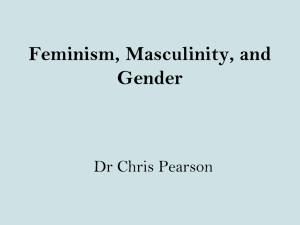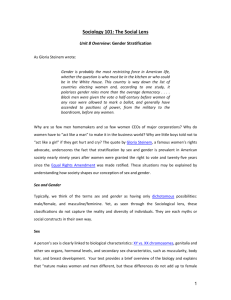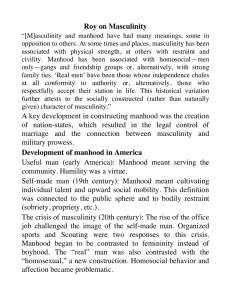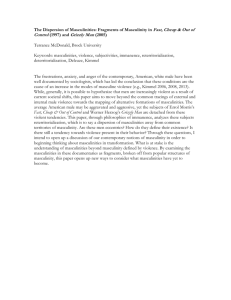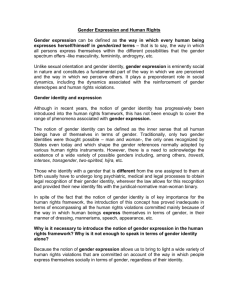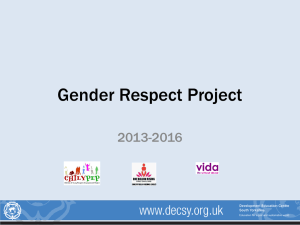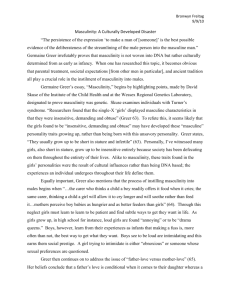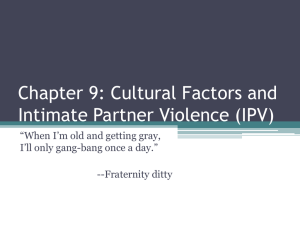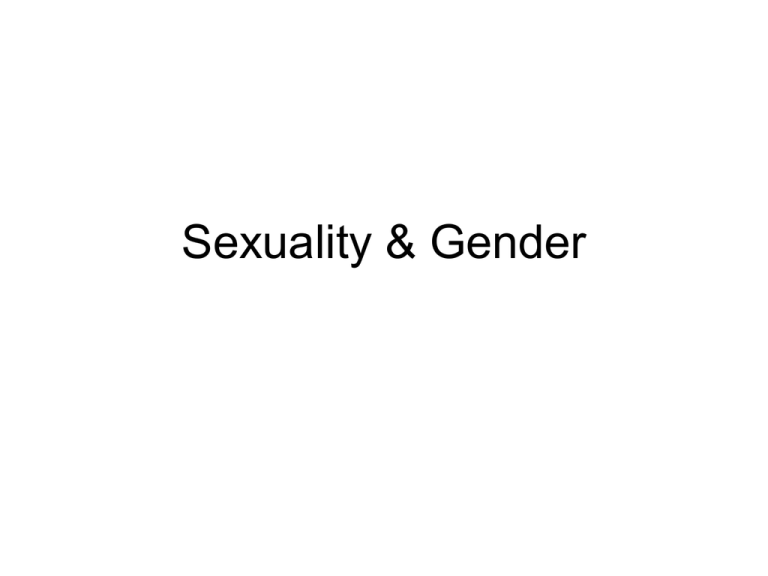
Sexuality & Gender
THE NATURE OF FEMALE AND
MALENESS
•
Our satisfaction with our own body is very crucial. A transsexual person
says he wishes he did not have a body at all after having undergone the
operation.
• Who is he who is she sometimes becomes very confusing especially in the
case of transsexualism.
Gender Differences
• Gender is a social identity covered by a set of social roles based on this
identity. In very general terms:
• She refers to anatomical and physiological differences that define male and
female bodies.
• Gender by contrast concerns the psychological, social and cultural
differences between males and females which is socially constructed
notions of masculinity and femininity.
• Gender is not necessarily a direct product of individual’s biological sex.
• Many differences between sex and gender is a fundamental one, since
many differences in males and females are not biological in origin.
Natural Differences
• Our behaviour is coming from our biology or
gender? And in which extend?
• Do our natural factors responsible for gender
inequalities? For example, hunting men figure
cross culturally is evidence of men’s physical
strength and aggression. If it is so there is a
difference between cultures regarding ‘gentle
woman’ or ‘aggressive man’.
Gender Socialization
• Learning social roles with the help of social organizations like the
family or the media.
• Gender roles are biologically determined but socially constructed.
Hence gender equalities are the results of different man and
women’s socialization.
• Gaining gender roles are supported by positive or negative
sanctions.
• Functionalist approach stressed that socializing agencies contribute
to the maintenance of social order.
• The critic toward this interpretation says that socialization theories
ignore the social expectations surrounding sex roles. For example
they may limit individual preferences.
The Social construction of
Gender and Sex
• Recently sociologists have been discussing that both sex
and gender are culturally constructed. Not only gender
but also human body itself is subject to social forces as
we consider about piercing, dieting, sex change
operation etc...
• The perspective that accepts there is a biological basis
of gender thinks that sex provides a social framework for
gender roles. Contrary to this argument, second group
sees both sex and gender to be socially constructed.
Sex differences are used to shape those differences
socially.
Perspective on Gender Inequality
• Functionalists
Division of labour between men and women is biologically
based and universal. Women are attached to domestic
and family responsibilities while men to outdoor duties.
Nuclear family in industrial societies is the key agency of
socialization. Women are defined with their expressive
roles, men are instrumental roles and these roles are
complementary (T. Parsons).
Mother is crucial for child’s socialization. A child separated
from the mother may have social and psychological
difficulties in his/her adulthood. Even a mother substitute
should be a woman (J. Bowlb).
Perspective on Gender Inequality
Liberal Feminism
• Women’s subordination is not a part of social system. Thus equal opportunities and
access for women are needed for gender equality.
Radical Feminism
• They offered a new concept, patriarchy which is historical systematic cross cultural
domination of females by males.
• Men control women biological reproduction and labour.
• The family contains variety of disadvantages for women.
• They debate on sexual harassment, rape, pornography, violence against women,
social pressure of western beauty over women.
• For media studies the most important contribution of radical feminists is the argument
of women’s objectification through the media.
Black Feminism
• Women’s struggle is not only the struggle of white middle class women.
• Other feminist did not consider ethnic women’s double burden, being woman and
ethnic.
• In black feminism, family represents a main point of solidarity against racism.
• Gender equality without taking into consideration black women cannot be reached.
Patriarchy
• The dominance of men over women. All
known societies are patriarchal, although
there are variations in the degree and
nature of the power men exercise, as
compared with women.
Sylivia Walby: Theorising
Patriarchy
• There is no unchanging and uniform oppression over
women in the world. Patriarchy changes according to
other conditions and works harmoniously with other
forms of oppression like capitalism.
Walby describes six patriarchal structures:
-in production relation
-in paid work
-in state
-in male violence
-in sexuality
-in cultural institutions
Gender Identity
Freud Theory of Gender Development
Presence and absence of penis are symbolically referring masculinity and femininity.
The boy unconsciously generates hostile feelings to his father and represses his erotic feelings
towards his mother.
The boy identifies himself with his father by recognizing his authority and his own male identity.
Finally the boy gives up his love for his mother out of unconscious fear of castration by his father.
The girls devalues her mother since they both unconsciously suffering from lack of penis.
Finally the girl gives up and identifies with her mother and takes over her submissive attitudes.
Both boys and girls learn to repress their erotic feeling between age of 5 and puberty (latency period).
During this period same-sex- peer-group becomes very important for children.
Critics by feminists and other authors (by Mitchell 1973’ Coward 1984)
-Freud defines sexual identity with genital awareness.
-Theory sees that penis is superior to vagina.
-There are many culture in which mother is main figure in disciplining.
-Gender roles learning begins earlier instead of after age of 5.
Gender Identity
Chodorow’s Theory of Gender Development
Mother is more dominant figure in gaining gender identity.
Children have to break the attachment to their mothers to get a separate sense of self.
Broken up process experience by boys and girls differently. Boys’ breaking up is sharp while girls still
has close relations with her mother.
Girls dependency changes in time first, her mother and later another man. This experience make
woman more sensitive and emotional.
Boys are less skilled in close relation less able to understand their own and the other’s feelings.
Reversing Freud’s assumption Chodorow states that the loss is what the boy losses, which close
attachment to the mother.
While men are afraid of close relation by thinking that their male identity is endangered, women have
the same fear in the absence of close relation.
Men become more manipulative and women become more expressive. Critics (by Sayers)
Women’s struggle to be independent is ignored in her explanation.
Women can express their aggression and assertiveness in direct ways and in certain contexts.
The family in which boys and girls gain their gender identities is white, Western and nuclear family.
Femininities Masculinities and
Gender Relation
Gender and Power by R. W. Connell
• Masculinities cannot be understood separate from
femininities,
• Gender relations organized around men’s dominance
are seen in daily practices, collective social
arrangements.
• Gender relations are constituted in three realms of
society: Labour (gender division of labor), power
(authority in institutions like family, state) and cathexis
(emotional).
• Gender regime is the configuration of gender relations
within a particular setting, such as school, a family or a
neighborhood.
Gender Hierarchy by Connell
• There are different expressions of
femininity and masculinity.
• Ideal types of masculinities is hegemonic
masculinity which is associated to
heterosexuality, marriage, authority, paid
work, physical and emotional toughness.
• Emphasized femininity is complementary
to hegemonic masculinity, serving
interests and desires of men.
Transforming Masculinities
Gender relations are open to change and
challenge.
Crisis in Masculinity
Crisis of institutionalization: Weak men power in
institutions and men’s power is underminded.
Crisis of Sexuality: Heterosexuality is not
dominant.
Crisis in Interest formation: women friendly
regulations, anti-sexist attitudes.
The Betrayal of the Modern Men
• Men’s gender roles in modern American
society loss importance in the job market,
family, relationships.
• They are not breadwinner any more.
• There is no traditional loyalty and
commitments.
• No self-worth and usefulness emotionally
among men.
Population
Total (millions)
44.5
56.1
60.6
65.3
425.8
474.3
466.3
647.0
Female population (% of total)
49.6
49.3
49.4
49.5
52.4
51.8
50.1
50.2
Male
59
64
66
67
63
64
62
67
Female
64
68
71
72
72
74
68
73
Male
17.1
10.8
8.3
6.5
3.3
1.7
14.2
8.4
Female
46.0
33.5
28.0
23.5
7.7
4.7
21.7
11.9
Total labor force (millions)
19
24
28
31
214
238
184
288
Female labor force (% of total)
36
35
36
38
47
46
33
37
10.9
8.0
6.9
8.3
..
11.1
..
9
23
8.5
6.5
6.6
..
11.1
..
8.9
Life expectancy at birth (years)
Adult illiteracy rate (% of people
aged 15+)
LABOR FORCE PARTICIPATION
Unemployment
Total (% of total labor force)
Female (% of female labor
force)
EDUCATION ACCESS AND
ATTAINMENT
Net primary enrollment rate (% of
age group)
Male
..
..
98
104
..
..
..
98
Female
..
..
94
96
..
..
..
96
Progression to grade 5 (% of
cohort)
Male
..
98
93
..
..
..
..
..
Female
..
97
96
..
..
..
..
..
Primary completion rates
Male
..
..
..
..
..
..
..
..
Female
..
..
..
..
..
..
..
..
4.3
2.9
1.9
1.2
1.2
0.5
7.6
4.4
20.2
11.7
8.4
6.0
4.0
1.7
10.2
4.3
Youth illiteracy Rate (% of people
aged 15-24)
Male
Female
Media Portrayals by J. Rutherford
Two idealized man images in the media
1. Retribute men: traditional masculinity.
2. New men: sensitive, caring, portrayed as
object to female gaze.
Gender Trends
•
•
•
•
•
•
•
•
•
•
•
•
The Turkey NHDR maps show clearly that high male human development is present in about two thirds of the country, largely in the east,
centre, south-west and south of the country, while high female human development is concentrated in the more urbanized provinces of
Ankara, Istanbul/Kocaeli and Izmir, where they have almost the same HDI status as men.
In the country as a whole, in statistical terms, women have lower HDI values than men (0.648 for women and 0.824 for men). The malefemale HDI is largest in the province of Diyarbakir, in the east of the country.
Of the three components of HDI, women are clearly disadvantaged with respect to two of them, namely per capita income and educational
attainment, while enjoying a biological advantage in the third (life expectancy).
Gender disparities are reviewed in terms of politics, employment, health and education. Turkey’s ranking in terms of the Gender
Development Index was 45th out of 130 countries in 1995, and 98th out of 116 for the Gender Empowerment Measure (GEM).
With respect to women in public life and politics, women were given the suffrage in 1933, and in the following national elections obtained
18 seats in the Legislative Assembly or 4.5% of the total. In remarkable contrast, and despite having a woman as Prime Minister, in1996,
there were only 13 women parliamentarians, holding only 2.4% of the seats. (in Norway it is 39.4%).
Women have fared even worse in local elections, having won only 1% of seats in the 1994 municipal elections, and less than 0.5% of
positions as mayors.
The main issues with regard to women and employment relate to unequal job opportunities and unequal pay, whereby on average
women’s non-agricultural wage is 84.5% of men’s.
Women are well represented in professional occupations, with 29% of all lawyers, 32% of all university academic posts, 39% of architects
(13% in US), 39% of dentists (9% in US), and 35% of all public employees.
In the medical profession, 70% of all graduating physicians in 1994/95 were women. This picture is very different at lower social levels,
whereby in 1990, only 17% of the urban work force were women, including 32% of clerical and related workers (compared with over 75%
in the US and Europe).
With regard to women’s health, fertility and family, Turkey still lags far behind the industrialized world in these areas. The total fertility rate
has declined significantly in recent decades from 5.7 in 1965 to 3.6 in 1989 and 2.7 in 1993, indicating marked progress since the
introduction of the first Family planning Act in 1965.
The transition from high to low fertility in Turkey is considered to be unique in the Middle East, but once again there is much variation
among regions and social groups. The total fertility rate for urban centres is 2.4 and 3.1 in rural areas. The main contributory factor to
declining fertility has been and to education and an increase in a women’s marriage age, for instance from 17.6 years in 1983 too 22 in
1990.
Finally, education is considered to be a major factor underlying gender disparities in Turkey. While there is still a gap in literacy between
males (91.3%) and females (76.1%), (compared with 86.4% and 68% respectively in 1985), the gap has been narrowing fast.
Discussions
• Do women and men have equal access to
valued resources? Are women’s and
men’s roles valued similarly?

